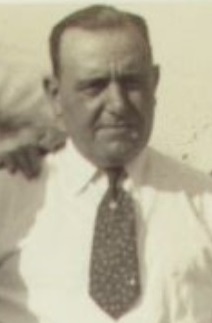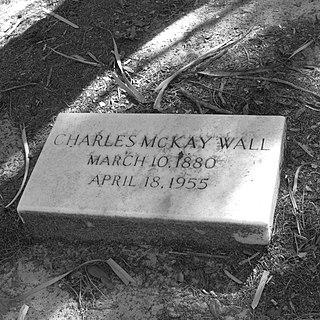History
Early underworld bosses in Tampa
During the early 1920s, Charlie Wall created an organized crime syndicate in Tampa, where he controlled a large number of illegal gambling rackets and corrupted many Tampa government officials through bribery. Wall controlled his organization from the Tampa neighborhood of Ybor City, and employed Italians, Cubans and men of other ethnicities in his organization. His only rival for criminal rackets in the Tampa Bay area was Italian Mafia boss Ignacio Antinori. [2]
Ignacio Antinori, a Sicilian-born immigrant, became a well-known drug kingpin and the Italian crime boss during the late 1920s. But there was also a smaller independent Italian gang led by Santo Trafficante Sr. that was operating in the Tampa area. Trafficante, had lived in Tampa since the age of 18, and had already set up Bolita games throughout the city and was becoming a powerful mobster. Antinori took notice of Santo Trafficante and invited him into his organization and together they expanded the Bolita games across the state of Florida.
By the 1930s, Antinori and Wall were in a bloody decade-long war, which would later be known as "Era of Blood". On March 8, 1938, Wall's closest associate, Evaristo "Tito" Rubio, was shot on his porch. The war between the two continued on for years, until October 23, 1940, when Ignacio Antinori was shot and killed by a shotgun blast to the head at the Palm Garden Inn in Tampa. [3] In 1943, Antinori's two sons Paul and Joseph were convicted in Kansas City for drug dealing and sentenced to four years in prison finally ending the decade long war. [3] Both Wall's and Antinori's organizations were weakened, leaving Santo Trafficante as one of the last and most powerful bosses in Tampa. [2]
Trafficante Sr. and the casinos in Cuba
By the early 1940s, Santo Trafficante Sr. had taken over most of the organized crime activities in the city and started teaching his son Santo Trafficante Jr. how to run these criminal operations. Trafficante Sr. became as a successful Tampa cigar factory owner. [4] During the late 1940s, Trafficante Sr. came under constant police surveillance and attempted to avoid the unwanted attention by making Salvatore "Red" Italiano his acting boss.
In 1950, Senator Kefauver began an investigation into organized crime, founding what would become known as the Kefauver Committee. The Committee called on Tampa mobster Charlie Wall to testify about organized crime in Tampa and Florida as a whole. To avoid testifying, both Trafficante Sr. and his son fled to Cuba. Trafficante Sr. had always wanted to enlarge his illegal activities in Cuba and dispatched his son, Santo, Jr., to Havana in 1946 to help operate a mob-owned casino. The Tampa mob made a considerable amount of money in Cuba, but never achieved its ambition of making the island part of its territory. After the hearings ended, the Trafficante's returned to Tampa to find out that Italiano had fled to Mexico, leaving Jimmy Lumia the biggest mobster in the city. Santo Sr. had Lumia killed after finding out that Lumia had disparaged him while he was in Cuba. With Lumia eliminated, Trafficante was once again the primary organized crime figure in Tampa.[ citation needed ]
In 1953 Santo Jr. survived a shooting. The family suspected the perpetrator was Charlie Wall and consequently, in 1955, had him killed. Trafficante remained the boss of Tampa until he died of natural causes in 1954. [2] [1]
Trafficante Jr. era

Santo Trafficante, Jr. was born in the United States on November 15, 1914, as one of five sons of Mafia boss Santo Trafficante. Santo Jr. succeeded his father as the boss of Tampa upon his death. Santo, Jr. never spent a day in jail, and he died of natural causes in 1987. [5]
Despite numerous unrealized ambitions, he was regarded as one of the most powerful mob bosses of the American Mafia and ruled his family with an iron fist. [1] During the 1950s, Trafficante Jr. maintained a narcotic trafficking network with Tommy Lucchese, the boss of the Lucchese crime family in New York City. [6] Trafficante Jr. had known Lucchese since the 1940s, when his father and Lucchese had trained him in the mafia traditions. [6] Trafficante Jr. would frequently meet with Lucchese in New York City for dinner. [6]
Santo Jr. was deeply involved in the CIA efforts to involve the underworld in assassination attempts on Fidel Castro. [1] Under pressure of a court order granting him immunity from prosecution, but threatening him with contempt if he refused to talk, Trafficante admitted to a Congressional committee in 1975 that he had in the early 1960s recruited other mobsters to assassinate Castro.[ citation needed ] "It was like World War II" he told the committee. "They told me to go to the draft board and sign up."[ citation needed ]
In 1978, Trafficante was called to testify before the United States House Select Committee on Assassinations investigating possible links between Lee Harvey Oswald and anti-Castro Cubans, including the theory that Castro had President John F. Kennedy killed in retaliation for the CIA's attempts to assassinate Castro. [7]
Leadership under LoScalzo
In 1987, Vincent LoScalzo became boss of the Trafficante family and Florida was declared an open territory, meaning that the Five Families of New York City could operate in any city in Florida. LoScalzo controlled a much smaller family, as over the years many of the older mobsters retired or died and few were replaced with new members. [8] As the new boss LoScalzo maintained control of criminal interests in illegal gambling, prostitution, narcotics, union racketeering, hijacking and fencing stolen goods. He also controlled a few bars, lounges, restaurants, night clubs and liquor stores across Florida. Loscalzo maintained ties to Mafia families in California, New Jersey, and New York as well as being connected to the Sicilian Mafia.
On July 1, 1989, LoScalzo was indicted on racketeering charges, including grand theft. The charges were later dropped and then reinstated. LoScalzo pleaded no contest on October 7, 1997, and received three months of probation. In 1992, LoScalzo was arrested at the Tampa International Airport for carrying a loaded .38-caliber pistol in his brief case. The weapon was detected by an X-ray scanner. He was convicted in 1999, and was sentenced to 60 days in prison. [8]
On October 26, 2000, federal authorities arrested Steven Raffa, along with eighteen members of Trafficante family's Miami faction. [9] Raffa, the leader of the family’s Miami faction, committed suicide on November 16, 2000. [9]
Current status
It was reported on November 25, 2007, Vincent LoScalzo was in his 70's and considered a semi-retired mobster and just a "regular Joe" according to Scott Deitche, author of Cigar City Mafia. The old family membership has died and the Tampa Mob has fallen into the shadows of the New York mobs. [10]
On August 5, 2008, the Tampa and New York FBI indicted John A. "Junior" Gotti, along with John A. Burke, James V. Cadicamo, David D'Arpino, Michael D. Finnerty and Guy T. Peden on charges of racketeering, kidnapping, conspiracy to commit murder and drug trafficking. [11] The indictment stated that Gotti Jr. along with the other men had been involved in various criminal activities in Tampa and New York during the early 2000s. [11] Evidence from the 2004 and 2006 trials of John Alite, Ronald J. Trucchio, and Charles Carneglia connected Gotti Jr. and others to criminal operations in Tampa, Florida. [11]







